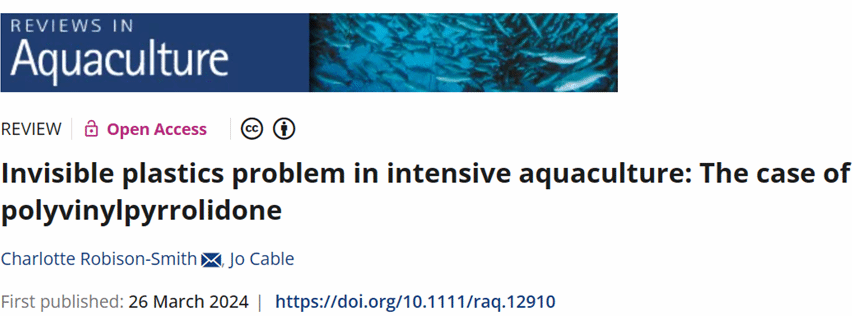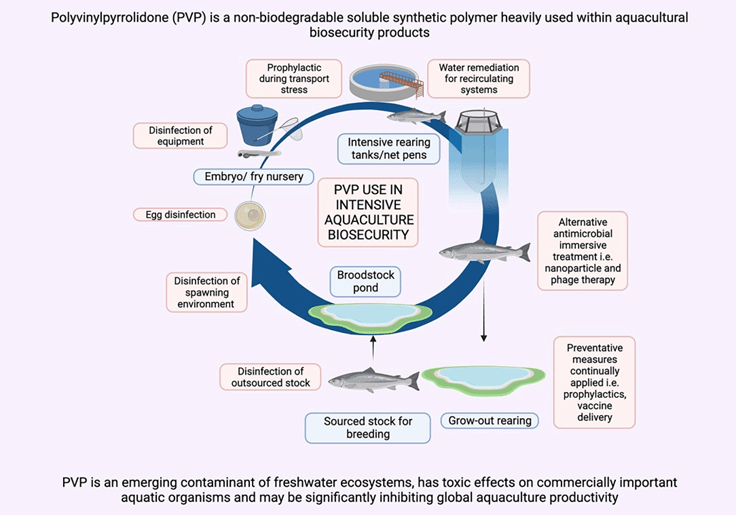集约化水产养殖中隐形的塑料问题:以聚乙烯吡咯烷酮为例
(资料来源:Reviews in Aquaculture)


鱼类养殖的各阶段(蓝色)和相应的生物安全过程(橙色)
摘要
在近70余年的水产养殖生产实践中,我们一直采用同样的方法来保证生物安全,但是水产病害仍是全球水产养殖产量的主要限制因素,并且每年因病害问题造成的收入损失高达数十亿美元。由于鱼类和贝类通常采用高密度养殖,因此从亲鱼到孵化以及在饲养的各个阶段中定期使用化合物作为预防和治疗水产病害的措施是十分必要的。然而,这种做法会导致养殖环境受到持久性外源物质的污染。因此,本综述特别指出了这一水产养殖生物安全防治方法的明显缺陷:在水产动物的大部分(及时不是全部)养殖阶段,一直在使用水溶性聚合物聚乙烯吡咯烷酮(PVP)。PVP是市场上常见的一种杀菌、预防和治疗疾病的产品,并且在水产养殖过程中被大量使用。PVP是一种人工合成的、难以生物降解的聚合物,并且是一种在淡水生态系统中发现的新型污染物。有研究表明,其他持久性合成聚合物污染物(如微塑料)会降低重要水产经济物种的繁殖力和生长速度,并严重削弱其免疫功能。尽管如此,特别添加的持久性可溶性聚合物(如PVP)尚未被纳入水产养殖生产力的考虑范围。总之,本综述探讨了PVP对鱼类和贝类的潜在影响,强调了在水产养殖中使用可持续的化学方法的必要性,并可借鉴已应用于人类药物的纳米技术来弥补生物安全常规做法中的不足。
关键词
生物安全,疾病,鱼类/贝类养殖,聚维酮,可持续性化学物质的使用,水溶性合成聚合物
英文摘要
Abstract
For over 70 years, aquaculture practices have relied on the same methods for biosecurity, however epidemics remain a primary limitation of global aquaculture yields with billions in revenue being lost every year due to disease. The intense nature of fish and shellfish farming necessitates the regular use of synthetic chemicals as both preventive and treatment measures, covering broodstocks to hatching and continuing through all stages of rearing. This practice, however, results in the contamination of rearing environments with persistent xenobiotics. A specific drawback in this foundational strategy for aquaculture biosecurity is highlighted in the current review: the consistent use of a water-soluble polymer polyvinylpyrrolidone (PVP) across most, if not all, stages of rearing aquacultural livestock. PVP is used intensively within aquaculture practices as it is a ubiquitous additive within commercially available germicidal, prophylactic, and therapeutic products applied to control and prevent disease outbreaks within aquacultural farms. As a polymer, PVP is synthetic and biodegradation-resistant, and has recently been described as an emerging contaminant of freshwater ecosystems. It is well documented that other persistent, synthetic polymer pollutants such as microplastics, reduce the fecundity, growth, and significantly deplete immune function in commercially important aquatic species. Despite this, intentionally added persistent soluble polymers, such as PVP, have not been considered in the context of aquaculture productivity. This review explores the potential impact of PVP on fish and shellfish highlighting the need for aquaculture to adopt sustainable chemical practices, drawing inspiration from advancements in nanotechnology applied within human medicines to address biosecurity protocol deficiencies.
Keywords:
biosecurity, disease, fish/shellfish farming, povidone, sustainable chemical use, water-soluble synthetic polymers
免责申明:我们在分享的同时,十分尊重原创,版权归原创作者所有,如有侵权请联系我们,我们将及时删除